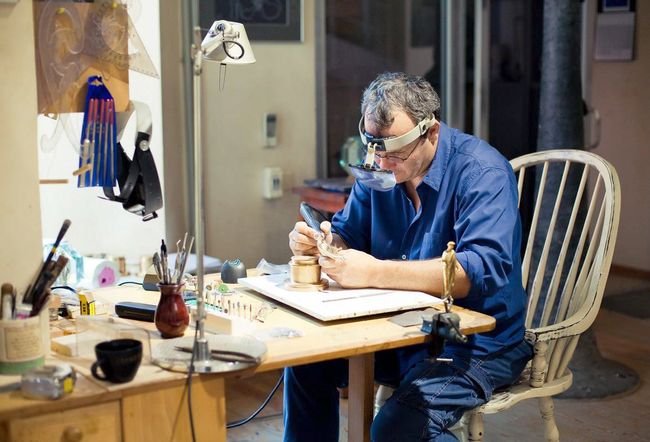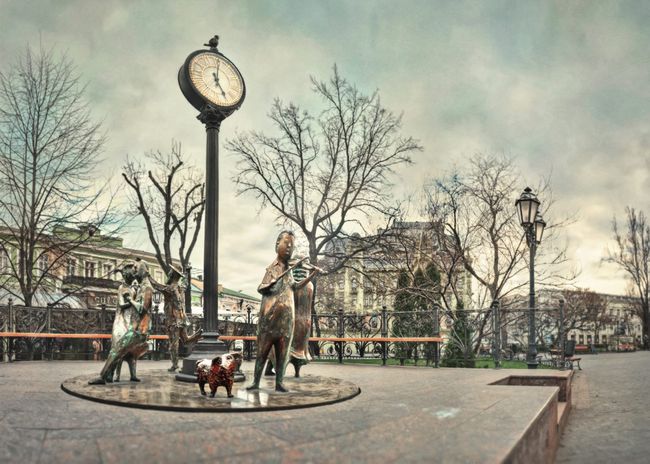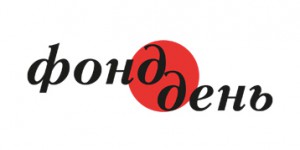Mykhailo Reva from Odesa is among Ukraine’s most successful sculptors. His talent expresses itself in small and monumental forms, and he works in graphics and jewelry as well.
Reva was born in Kerch on March 13, 1960. In 1966, he moved with his parents to Odesa. He graduated from a nautical school in 1977 and did his military service in 1980-82. Aged 25, he entered the Mukhina Academy of Decorative Arts and Design (currently known as the Stiglitz St. Petersburg State Academy of Arts and Crafts). He received the Golden Medal of the Academy of Arts of the USSR for the best diploma work of 1990 in the field of architectural and decorative plastics. The Academy sent him on a scholarship to the Abamelek Villa in Rome (Italy). Having completed that internship, he returned to Odesa.
Reva’s most famous work in Kyiv is the monument to the victims of terrorism; in Odesa, he cooperated with the classic contemporary artist Ernst Neizvestny (1925-2016) in creating The Golden Child monument (he made the bas-reliefs The Cardinal Directions). One can name many other Reva’s works in Odesa and Kyiv. His latest work is the sculptural composition The Doors of the Sun in the Langeron neighborhood, which was unveiled in July.
The artist is married and has a daughter.
THE BEGINNING
“The maternity hospital in Kerch, where I was born, was standing right in the middle of an ancient Greek excavation site. There were huge mountains of ancient potsherds of the 3rd century BC there, where I was running about as a child. However, I started my career in a different line of work, as I graduated from a nautical school. My father was a foreign-going master mariner, and he told wonderful stories every time he came home. Therefore, I thought that I would be a sailor, I had such a childish passion. And then I, a lad who had grown up in a khrushchevka apartment, got to downtown Barcelona in 1977, and saw Antoni Gaudi’s Sagrada Familia Church. The captains with whom I worked were friends of my father, so they took me to various museums, galleries, and this was my first university.

Photo from Mykhailo REVA’s Facebook page
While books by Salvador Dali, Pablo Picasso, and Ossip Zadkine were underground reading under the Soviets, I saw it all live. And then came the realization that this should become part of me. Therefore, I entered the Mukhina School in Leningrad, and I was lucky to have a great teacher there, I mean Lyudmila Kalugina. Starting in the first year, we went to Moscow, to Vadim Sidur’s studio. They took us to see exhibits kept in storerooms of the Russian Museum, we saw works by Pavel Filonov and other figures of the Russian avant-garde. I was like a fertile ground in which they had to sow the right seeds. I turned down an offer to pursue postgraduate studies in St. Petersburg because as a southerner, that city’s swampy climate is contraindicated for me. They offered me a scholarship in Italy, but I had realized one thing by then: we will never achieve anything there. We can become good professionals, but self-fulfillment is off-limits. After the USSR collapsed, an opportunity appeared to implement my ideas here. It is difficult but possible.”
THE ENVIRONMENT
“I can enter any courtyard near Odesa’s Privoz Market and experience a cultural shock of unequalled magnitude, as all the galleries of the world cannot rival its truth of life. Cultured Europe visits galleries or museums to get this shock. We, however, have it the other way round. We came out of cultural vacuum and pathological lies, and we had to develop somewhat differently.

Photo by YAKOV HANZELMANN
“I am interested in space only. Look at the Duke [the monument to the Duke de Richelieu, an early governor of Odesa. – Ed.], standing above the Potemkin Stairs. It is just over two meters tall, but it holds a huge space together. If you take it from there, everything will collapse. A sculpture is a cornerstone that enters the space and holds it together. I allow that it may be a new thing, but it is so organic there that a person who has passed by a thousand times perceives it as if it always stood there. This is the rule.”
THE MATERIAL
“I love all the materials. There is simply a task that needs to be addressed in every case. I can make a bronze work from plaster, a stone figure from plastic, but the energy of the material is very important.

Photo from Mykhailo REVA’s Facebook page
When you understand and feel it, you can cope with the task in a clear-cut manner. Stone is higher-energy. When you rub it, you get charged. You get tired, but feel fertilized all the time. Stone gives you strength.”
GRAPHICS
“It is always easy, it is improvisation similar to sheet music. I have a small notebook here, and just paint there from time to time. Touches, pastels, watercolors... Meanwhile, sculpture is a long race from the first impulse, when you understood this form and found this solution, until it is completed in three or four years’ time. And the first impulse must correspond to the last one. In the graphics, you instantly see the result. I see it rather as a fun activity.”
SWEAT
“In sculpture, any mistake is very hard on the artist both in financial terms and in every other way. One needs to think about it very carefully before starting to work. One needs to see the entire space in its totality, following a system of generalization. Sculpture is a joy, but also sweat, and responsibility is great. Because of this, the sculptors are also a separate caste. After all, it is the oldest art, where technology has not changed for millennia. I use the most up-to-date equipment, the computer scans my work magnifying it enormously, but it is still a handmade mystery, I will still have to take burin and emery in hand, smooth out everything, and then it will gain energy.”
ARCHAICS
“I am very impressed with ancient art, which is powerful, high-energy, and sacred. The archaics is very monumental. Even looking at small clay figurines, the choice of shape and style is so clear that it, of course, influenced Pablo Picasso and Antoine Bourdelle, as well as many other artists. Not everything is revealed there, there is some whisper, mystery to it. With such things, one can communicate infinitely. They are very sincere and frank. I try to introduce these archaic motifs into my sculptures. But I also have it as part of my genetic legacy, because a great-grandfather of mine was a Greek who lived in Cyprus, while another great-grandfather was a sotnyk of the Zaporozhian Sich. We have a family legend about it.”
ERNST NEIZVESTNY
“Life goes through striking stages sometimes. I met Neizvestny almost immediately after graduation. He was an incredible person, since having survived the war and repression, he was a living embodiment of the era. His sculpture is just like that: angular, rigid, heavy, non-aesthetic, with a nerve. Still, each of his works contained the lead filling of philosophy. For me, he was a philosopher more than a sculptor, a nerve of time. We talked after the 9/11 attacks, I was in New York just then. He showed me his collection of graphics entitled ‘The Prophets,’ and it reflected that same state which I had experienced on September 11. He showed me what I had experienced.

Photo by YAKOV HANZELMANN
“The Golden Child provided a tremendous experience. I did all its technical components, as well as bas-reliefs with the cardinal directions. The passenger port is the ideal location for this sculpture, since its aesthetics simply would not fit in the old town. It is fit for a metropolis, for industrial centers. In order to counterbalance this brutal plastic, we decided to create a monetary field which would display all the money ever used in Odesa. We failed to do it, and I then made the ancient Greek-modeled bas-reliefs of the cardinal directions represented by eight winds, combining archaic and monumental plastic. It was initially met with ambiguous response, it was even rumored that after the installation of this monument, Odesa would drown, but as we see, everything is alright, and people have grown used to The Golden Child.”
THE DOORS OF THE SUN

Photo from Mykhailo REVA’s Facebook page
“I want to implement a big project – a landscape art park, which would extend from Langeron to Station No. 16. I have established a dedicated foundation, we accept applications from all over the world. The Expert Council will select the projects, then invite the authors. They will choose locations for these objects, then there will be an exhibition, and the city’s residents will vote on it. The objects that get the most votes will get created. It can eventually become a very interesting tourist route. To start this big project, I made The Doors of the Sun – a reincarnation of old Odesa doors. People threw them out, I picked them up, applied some art magic, and now they meet the sun and have become part of the embankment and tourist activity it houses. We have thus set a certain bar. I would like future objects to be original works.”
ODESA
“It is like Babylon, you know... I have ancestors of seven different ethnicities, as has my daughter. Such mixing is normal for Odesa. Therefore, the city is very tolerant, it does not care what ethnicity you are as long as you are a good person. You get recognized as a local based on your reputation. If it is good, then everything is fine. If you cheated someone, but did it elegantly, this is also a reputation. (Laughs.)

I like that the city never gets sad. Here, any problem can be met with a smile, and one goes on. True, little is left of Odesa of the old. But still, it somehow remakes everyone, there is some virus at work here... Odesa makes people love it, accept its spirit as one’s own. Besides, everything here, from the climate to the traditions of hospitality, is adapted to not working. It is terribly relaxing. Still, work must be done. I get a hold of myself.”
THE IDEAL
“In the ideal city, harmony of space and harmony of man are combined. It is a convenient place for living, creating, dreaming, and loving. Such a city should be very exploration-friendly, very interesting, and very diverse. Also, it should be human-scaled. Such an ideal does not actually exist, but it is necessary to strive for it.”
TO DREAM
“It seems to me that we did something very big in 2014. Even if no major success has been achieved so far, realizing that this is our land and our homeland is worth much. Ukraine has a great future, and I, too, hope to contribute to it. I am impressed by the generation that has grown up lately, and I think everything will be fine here. I would like us to move away from self-flagellation and pessimism, and fire up with optimistic, crazy ideas and projects instead. Then, a light at the end of the tunnel will appear. This cannot happen without dreaming. Everything is in our power, the most important thing is to realize that this is our land.”








